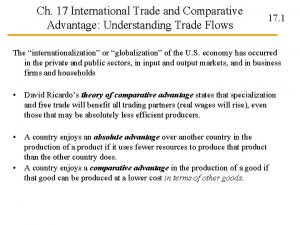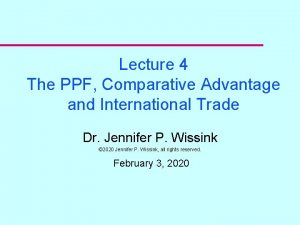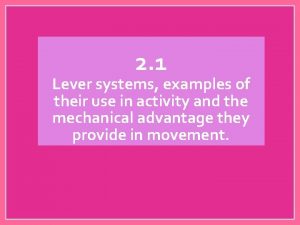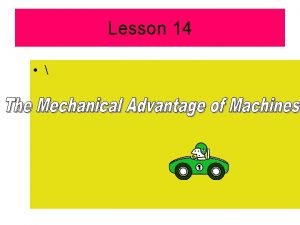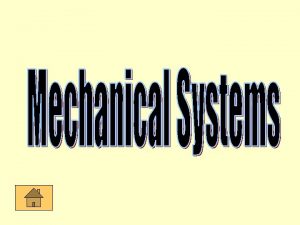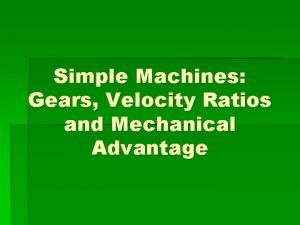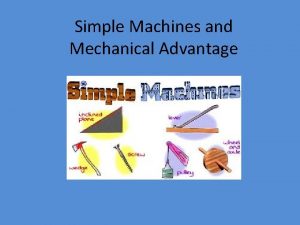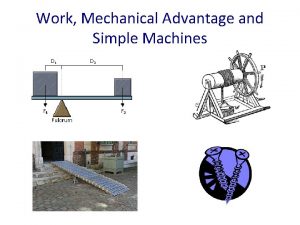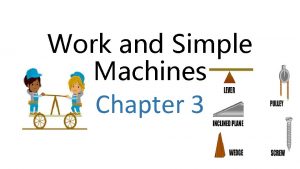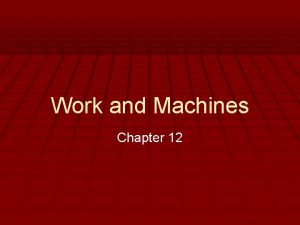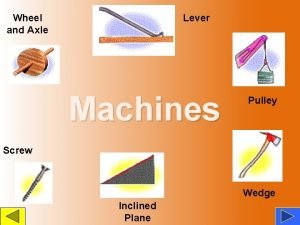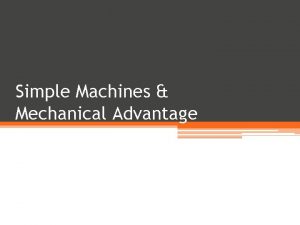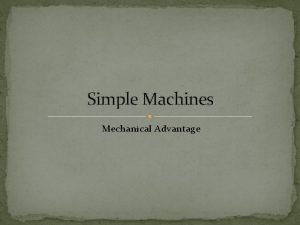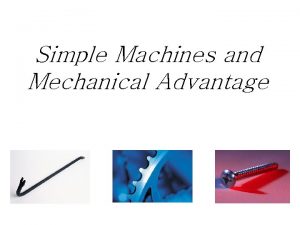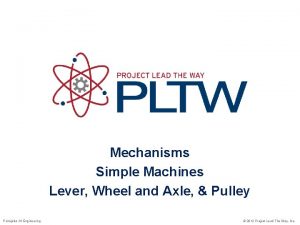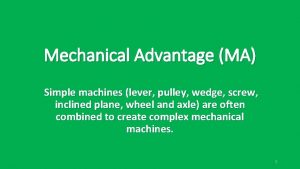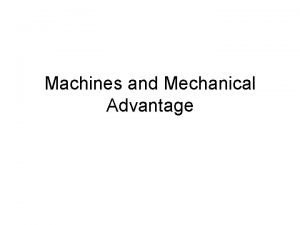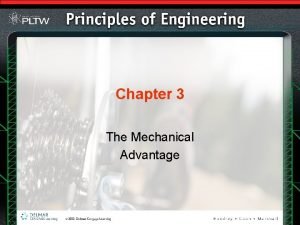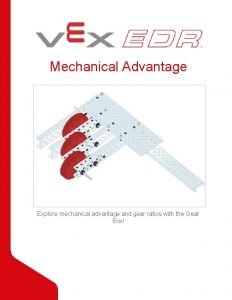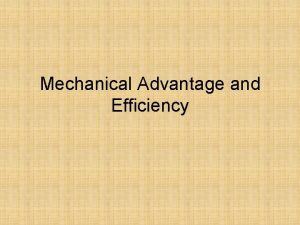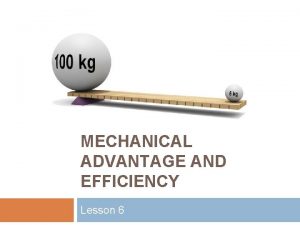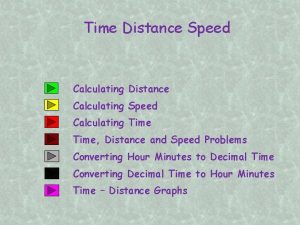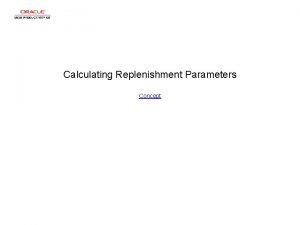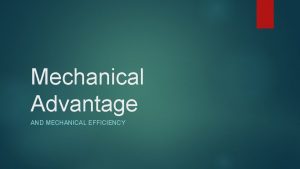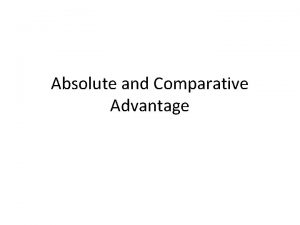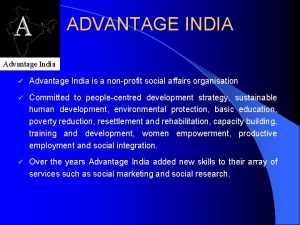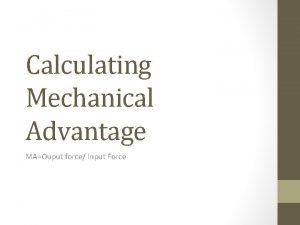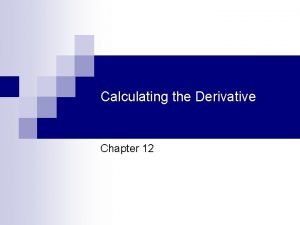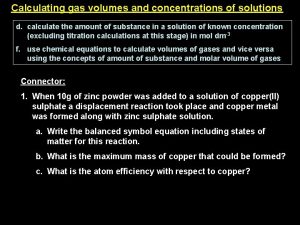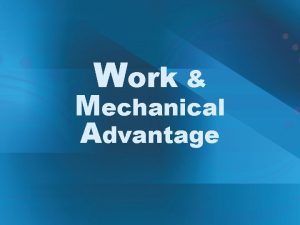Chapter 7 AWork and Mechanical Advantage Calculating Mechanical




















- Slides: 20

Chapter 7 AWork and Mechanical Advantage

Calculating Mechanical Work • What is work? • We will focus on Mechanical Work • When a force acts on an object to move it • 2 factors: force and displacement

Calculating Mechanical Work • Formula: W = Fd • Work = force x distance (displacement) • If no movement, no work • Pushing on a wall? No work

Machines

Really complex machines

Machines from science fiction ? Not quite there yet…. Exoskeleton

Simple Machines • What is a simple machine? • A tool made of basic mechanical parts • 3 types: • Levers • Wheels and axels • Inclined planes


Levers

Wheels and Axels

Inclined Planes

Using Simple Machines to Solve Problems • W=F x d • Unit for work is Joules (J) • What is the work done by a pulley that raises a 2490 N weight 53 m? • F= 2490 N • d= 53 m • W=Fd=(2490)(53)= 131, 000 N*m • W= 130, 000 J

Power • Quick note: • Power (P) is the rate of doing work • P = (W) / △t • W = work in Joules • △t = time in seconds • P is measured in watt (W)

Power • It takes 40 minutes to raise the weight before. How much power is needed? • P = (W)/△t • W = 131, 000 J • △t = 40 min * 60 sec/ min = 2400 s • P = (131, 000)/(240) = 54. 583333 J/s • P = 55 W

Simple Machines and Efficiency • What is The First Law of Thermodynamics? • Cannot create or destroy energy • No machine can create energy, only use energy you put in • But!!! Never 100% • Efficiency = (work that comes out) x 100% (work that goes in) Efficiency = (Wout)/(Win) x 100%

Mechanical Advantage and the Distance Principle • Machine make work easier • We need to give less force • Quick vocab: • Load/ resistance: system to be moved • Resistance force (Fr) = force needed to begin moving • Effort Force (Fe) = force actually exerted on the simple machine (or just effort)

Mechanical Advantage and the Distance Principle • Simple machines give you a mechanical advantage (MA) • Reduces the effort needed to do a certain amount of work • Does NOT reduce the amount of work needed • MA = weight/ effort

Mechanical Advantage and the Distance Principle • Note: we will always ignore friction in this book, so we are calculating ideal MA (IMA), not actual MA (AMA)

Mechanical Advantage and the Distance Principle • To conserve work & energy, simple machines use smaller force over a longer distance • Distance principle

Vocabulary quiz on Wednesday • Mechanical Work • Simple machines • Power • Watt • Load • Resistance force • Effort force • Mechanical advantage • Distance principle W=F x d
 Actual mechanical advantage vs ideal mechanical advantage
Actual mechanical advantage vs ideal mechanical advantage Calculating comparative advantage
Calculating comparative advantage Ppf
Ppf First class lever examples sport
First class lever examples sport Difference between ideal and actual mechanical advantage
Difference between ideal and actual mechanical advantage Wheel and axle formula
Wheel and axle formula Is a gear a simple machine
Is a gear a simple machine Wedge simple machine mechanical advantage
Wedge simple machine mechanical advantage Mechanical machine
Mechanical machine Fixed pulley
Fixed pulley How does mechanical advantage work
How does mechanical advantage work Lever inclined plane wheel and axle
Lever inclined plane wheel and axle Mechanical advantage of a ramp
Mechanical advantage of a ramp Advantage
Advantage Ancient simple machines
Ancient simple machines Pulley ima
Pulley ima Efficiency mechanical advantage
Efficiency mechanical advantage Pulley lever wedge
Pulley lever wedge How to find mechanical advantage
How to find mechanical advantage Gravitational potential energy
Gravitational potential energy Ideal mechanical advantage definition
Ideal mechanical advantage definition

